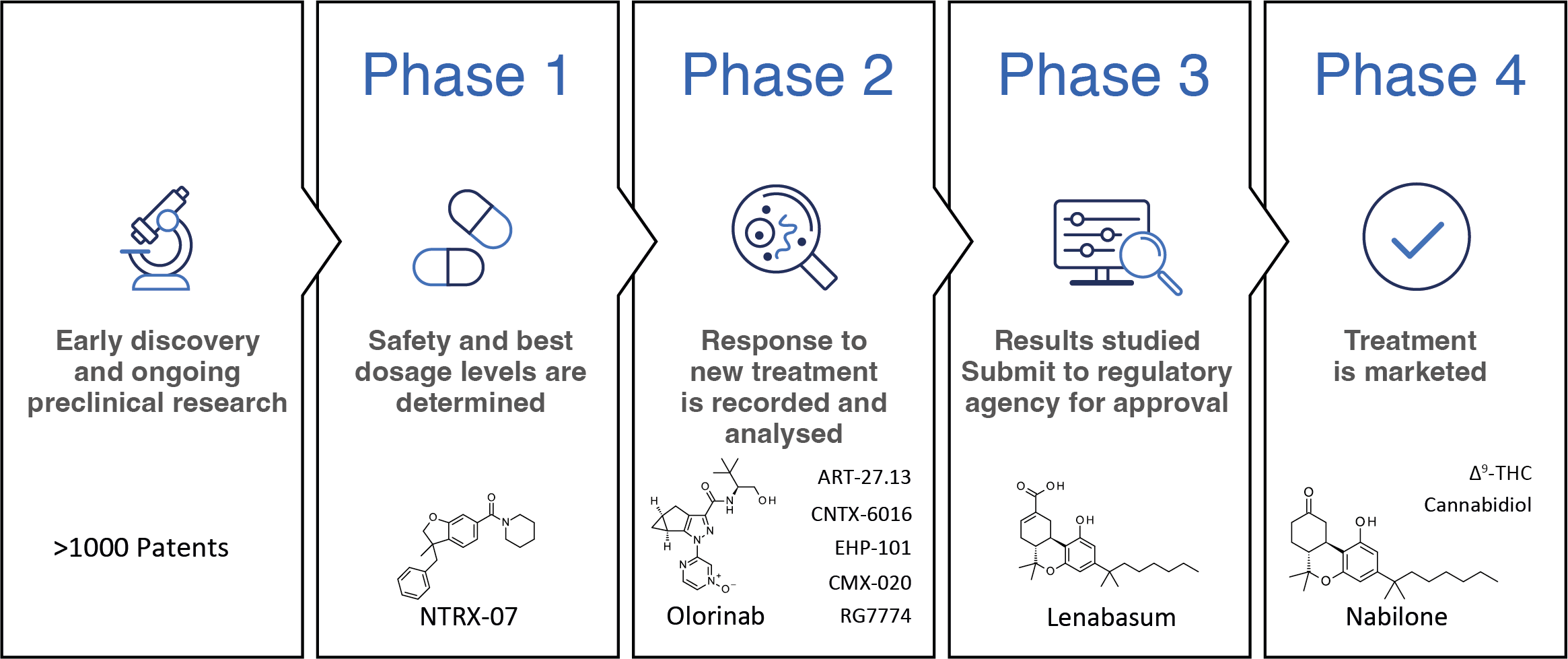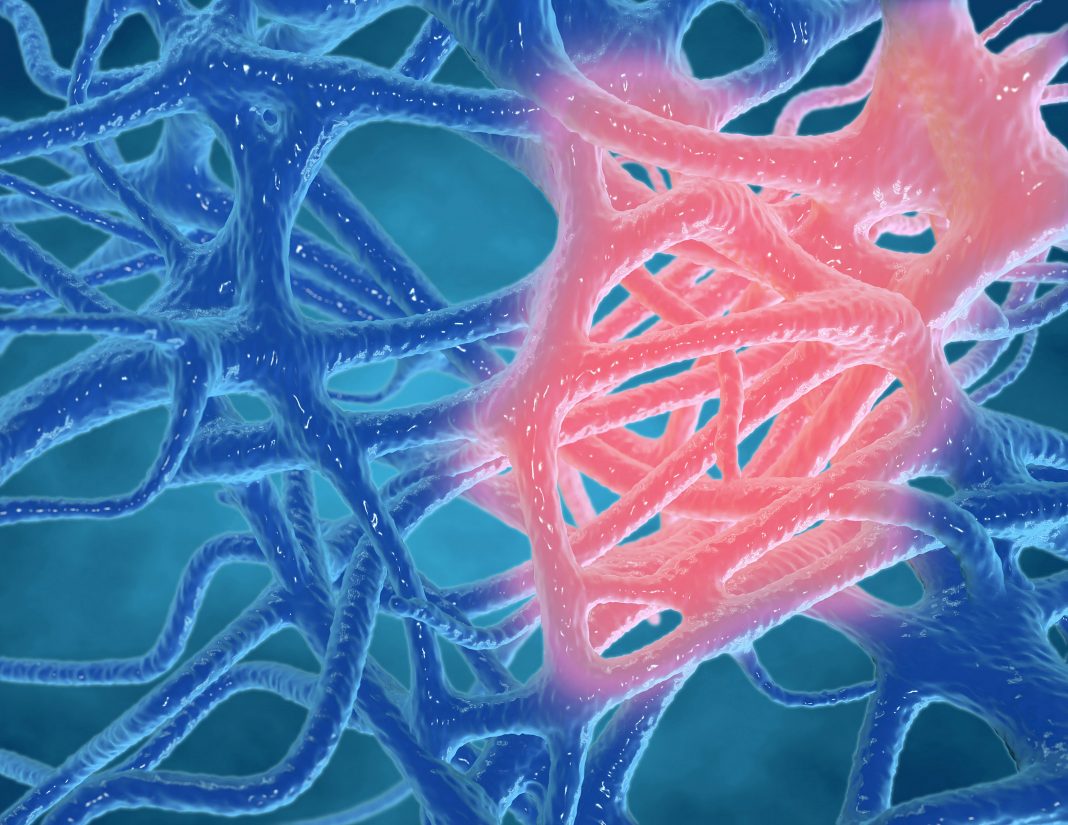Researchers give an update on clinical trials with CB2R agonists and their potential for the treatment of inflammatory diseases
Activation of the type-2 cannabinoid receptor (CB2R) holds great potential for treating diseases with an inflammatory component. This G-protein-coupled receptor (GPCR) is a key element of the endocannabinoid system (ECS), an important lipid signaling system.
Numerous small molecule activators, so-called CB2R agonists, demonstrated high efficacy in preclinical disease models for treating a multitude of pathological conditions such as cardiovascular, gastrointestinal, liver, kidney, lung, neurodegenerative/ neuroinflammatory, skin pathologies, rheumatoid arthritis, endometriosis, and eye diseases. (1)
In addition, several of these CB2R agonists progressed toward clinical stages and might soon provide solutions for high unmet medical needs and inflammatory diseases.
From Cannabis sativa to selective CB2R agonists
Since at least 1,000 BC, Cannabis sativa has been used for recreational and medicinal purposes, including anti-inflammatory treatments. However, it was not until 1964 that its main active ingredient Δ9-tetrahydrocannabinol (THC) was identified.(2)
The discovery of its pharmacological targets, the type-1 and type-2 cannabinoid receptors (CB1R and CB2R) did not occur until 1988(3) and 1993 (4), respectively. THC is a potent dual CB1R and CB2R agonist exhibiting multiple therapeutically relevant physiological properties, including anti-inflammatory, immunosuppressive and analgesic effects. However, central CB1R-mediated psychotropic upshots resulted in the regulation of its usage.(5)
To overcome this, two drug development strategies were followed by medicinal chemists: i) Limiting drug exposure toward the periphery in order not to engage with brain CB1R; and ii) enhancing the selectivity over CB1R.
Clinical trials with CB2R agonists
Overall, more than 20 CB2R agonists have been investigated in humans for a wide range of indications. The chemical drug structures in this context are highly diverse.
Fatty acid derivatives, classical and non-classical cannabinoids, and multiple diverse synthetic ligands are included, which also results in the coverage of a broad range of physicochemical properties. (1c, 6)

In clinical trials data on dosage, safety and therapeutic efficacy in humans are generated (Figure 1).
The overall study design aims to ensure the scientific validity and reproducibility of the results. Generally, clinical trials are divided into four phases.(7)
In phase 1 information on the pharmacokinetic profile of a new molecular entity is collected in a small group of people.
Furthermore, safe dose regimens and side effect profiles are determined. Phase 2 concentrates on establishing the preliminary efficacy of the drug in patients, usually against a placebo control group.
Phase 3 aims for final confirmation of the safety and efficacy data and is followed by the launch of the medicine. Finally, phase 4 studies continuously monitor a drug and delineate its risks, benefits, and optimal use over its lifetime.
Launched CB2R agonists & ongoing clinical trials
The first mostly unselective CB2R agonists, often bearing unfavourable overall absorption, distribution, metabolism and excretion (ADME) profiles and often focussing on pain indications, were halted in clinics for various reasons but did not raise any CB2R-related safety concerns.(8)
Phytocannabinoids Dronabinol, which is synthetic THC, Nabilone and Cannabidiol (CBD) exerting their action partially through CB2R activation, have been introduced to the market. Oral THC is used for treating anorexia, cachexia and chemotherapy-induced emesis.
At the same time, buccal THC has been launched for cancer pain. Nabilone is used for treating patients that suffer from chemotherapy-induced nausea and vomiting. CBD, a non-classical cannabinoid for which the main mode of action is still debatable, is marketed for treating infantile severe myoclonic epilepsy, Dravet and Lennox-Gastaut syndrome, and tuberous sclerosis.
Combinations of CBD and THC have been approved for treating MS-associated spasticity and pain management. Non-psychoactive dual CB1R/CB2R agonist Lenabasum is currently being investigated in phase 3 trials for treating systemic sclerosis and dermatomyositis.
The most advanced selective CB2R agonists are the synthetic cannabinoids Olorinab and RG7774. The clinical focus of Olorinab is on pain related to irritable bowel syndrome (IBS) and IBS with predominant constipation or diarrhoea. RG7774 aims to provide oral treatment to patients suffering from diabetic retinopathy. Arachidonic acid analogue CMX-020 is studied in phase 2 trials to treat pain, osteoarthritis and diabetic neuropathy.
Pain, in particular, neuropathic pain, is also the focus of the selective synthetic CB2R agonists CNTX-6016 (phase 2) and NTRX-07 (phase 1). Dual CB1R/CB2R agonist ART-27.13 is in phase 2, seeking to provide treatment options for cachexia and cancer-related anorexia. Cannabidiol derivative EHP-101, which activates besides CB2R also PPARγ, is aimed at multiple sclerosis and scleroderma patient populations (phase 2).
Together, these CB2R agonists hold very high potential for treating multiple diseases in which inflammatory processes play a significant role or are the underlying reasons.
Furthermore, recent advances in expanding the knowledge of CB2R protein structure and molecular pharmacology will enable the development of the next generation of CB2R agonist drugs, allowing an even more precise pharmacological targeting, thereby unlocking the high therapeutic potential of CB2R for treating inflammatory diseases.
Acknowledgements
We thank all colleagues who have contributed to our investigations on CB2R over the years.
References
- a) Maccarrone M, Grether U (2022) Is CB2R a hidden treasure trove for treating inflammatory diseases? Open Access Government, https://www.openaccessgovernment.org/article/cb%e2%82%82r-treating-inflammatory-diseases-endocannabinoid-system/145866/; b) Pacher P, Grether U (2023) Challenges bringing CB2R medicine to bedside. Open Access Government, https://www.openaccessgovernment.org/article/challenges-bringing-cb%E2%82%82r-medicine-to-bedside/150463/; c) Maccarrone M, Di Marzo V, Gertsch J et al (2023) Goods and bads of endocannabinoid system as a therapeutic target:Lessons learned after 30 years. Pharmacol Rev. Epub ahead of print, doi:10.1124/pharmrev.122.000600.
- Gaoni Y, Mechoulam R (1964) Isolation, Structure, and Partial Synthesis of an Active Constituent of Hashish. J Am Chem Soc 86:1646–1647.
- Devane WA, Dysarz FA, Johnson MR et al (1988), Determination and characterization of a cannabinoid receptor in rat brain. Mol. Pharmacol. 34(5):605-613.
- Munro S, Thomas KL, Abu-Shaar M (1993) Molecular characterization of a peripheral receptor for cannabinoids. Nature 365: 61-65.
- Robson P (2001), Therapeutic aspects of cannabis and cannabinoids. Br. J. Psychiatry 178:107-115.
- Whiting ZM, Yin J, de la Harpe SM et al (2022) Developing the Cannabinoid Receptor 2 (CB2) pharmacopoeia: past, present, and future. Trends Pharmacol Sci. 43(9):754-771.
- U.S. Food and Drug Administration (2018) What are the different types of clinical research? https://www.fda.gov/patients/clinical-trials-what-patients-need-know/what-are-different-types-clinical-research. Retrieved 25 May 2023.
- Brennecke B, Gazzi T, Atz K et al (2021) Cannabinoid receptor type 2 ligands: an analysis of granted patents since 2010. Pharm Pat Anal 10: 111-163.

This work is licensed under Creative Commons Attribution-NonCommercial-NoDerivatives 4.0 International.


